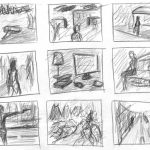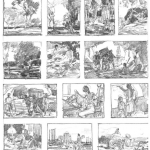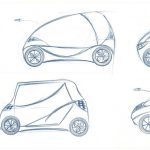Urban Artifacts
Problem: Create black & white figure-ground (stable and ambiguous) compositions based on the simplified forms created from photographs of discarded objects found on an urban sidewalk.
Limits: simple, flat, black shapes, no lines or text.
Materials: Sketchbook, camera/phone, photoshop, pencils, marking pens, 1 sheet Bristol Board 9×12″, ruler/t-square, tracing paper.
Concepts: Shape (Organic, Geometric), Frame, Figure-Ground (Obvious, Ambiguous), Unity, Economy
Technical Skills: thumbnail sketching, digital imaging, draughmanship with ruler/t-square, inking pens.
Design Process:
Phase 1: Discover
- Take a walk.
- Along the way you will be looking for small “urban artifacts” — detritus, objects or fragments of objects that have been discarded, lost, or destroyed.
- Compose 6 photographs:
- 3 compositions should demonstrate an obvious figure/ground relationship

Obvious figure/ground example
- 3 compositions should demonstrate an ambiguous figure/ground relationship

Ambiguous figure/ground example
- 3 compositions should demonstrate an obvious figure/ground relationship
Post to the Class Blog:
- Create a new blog post called Urban Artifacts: Phase 1 on the Class Blog.
- Upload the six images of the objects you discovered on the Urban Archaeology Walk.
- Add the following Category and Tags to your post:
- Category = COMD1100 Project #1
- Tags = Phase 1: Discover, Urban Artifacts
Writing
- Look at the images of the objects you discovered on your Urban Archaeology Walk.
- Think about the history of each object; the shape, the texture, how it ended up where it did.
- In your sketchbook write the heading: ‘Urban Artifacts’ and compose a minimum 1-paragraph description of the images. Describe the shapes. Are they geometric or organic? Note the figure/ground relationships. Which are stable or ambiguous and why? Create a 1-2 paragraph story about these artifacts, imagining how they happened to turn up in the location that you found them.
Documentation and Feedback
- Refine your writing. Don’t forget to spell-check and grammar-check.
- Edit your blog post Urban Artifacts: Phase 1 to include your reworked writing.
- Include the hours that you worked on this part of the project.
- Then comment on at least 1 other student’s post.
Goal: Develop an understanding of the two types of figure-ground relationships, obvious and ambiguous. Through experimentation and iteration create six compositions using pencil and paper, based on your original photographic compositions of urban artifacts.
Review Principles:
- Composition: The formal organization of elements in a composition arranged according to principles that will support the communication of the concept.
- Economy: Using only the elements necessary to communicate an idea, emotion, or formal concept. Less is more.
- Unity: Refers to the cohesive quality that makes a composition feel complete and finished. Unity gives it the feeling that all the elements relate to each other in a compatible way to form a unified whole.
- Organic shape: is one that resembles the flowing contours of an organism.
- Geometric shape: such as circles, triangles or squares often have precise, uniform measurements.
- Figure (positive space): The shape of a form that serves as a subject in a composition.
- Ground (negative space): The space surrounding a positive shape or form; sometimes referred to as ground, empty space, field, or void.
- Figure/Ground: The relationship between positive and negative space.
- OBVIOUS: An obvious figure-ground will generally have an imbalance of figure and ground (70/30), wherein the ground “supports” or surrounds the figure.
- AMBIGUOUS: An ambiguous figure-ground will generally have a closer balance of figure and ground (50/50), wherein the differentiation between figure and ground become blurred. Often the figure will intersect the boundaries of the frame.
- STUDENT EXAMPLES: Can you determine which image demonstrates Obvious and Ambiguous Figure/Ground? And why? Are they all successful or could some be improved? How?
Example 1 | Example 2 - REFERENCES: In these two examples notice the consideration of the figure-ground relationship and how it helps to unify the overall composition.
John Currin | Rousseau
Iterate – Thumbnail Sketches
- by tulvit
- by Loomis, Andrew.
- adaptanddesign.com
- sketches-visual-diary-portfolio
Thumbnail sketches or roughs are used to explore layout options. These are quick drawings allow the designer to try out a range of ideas and find the best compositions before beginning a project.
- Working from your urban artifact photographs, you will complete a total of 6-12 thumbnail sketches: a minimum of
- 3 obvious figure-ground compositions
- 3 ambiguous figure-ground compositions
- Choose one artifact from each set of obvious figure-ground and ambiguous figure-ground photographs.
- Consider the relationship between these two artifacts. Find some commonality (ie: stains on the ground, objects from the built environment, objects from nature, etc) or meaning (feeling, atmosphere, mood, etc.)
- Take a moment to think about the meaning that the two artifacts convey together and separately.
- Using an hb-2b pencil, draw out 6 boxes on a page in your sketchbook.
- For each thumbnail drawing create new compositions based on your urban artifacts.
- Adjust the placement until the arrangements feel unified. In some instances, you may need to economize, removing some elements in order to create a more unified composition.
- Observe the objects (figure) and the background layer (ground). Are the figure and ground present in equal proportions or unequal? How do they relate? Does the ground support the figure or fight for dominance?
Refine – Final Sketches
- Choose your two best obvious and two best ambiguous figure-ground sketches and refine.
- Using an economy of organic and/or geometric shapes, the final compositions should feel unified.
- Use a full page in your sketchbook (9×11″) to redraw and refine each of your compositions.
- NOTE: Adjust the orientation of the page (portrait or landscape), as needed, but consider choosing the same orientation for both compositions.
- There should be a clear transition from the photographs > to the thumbnails sketches > to the refined final sketches.
- When you are finished, take a photograph of your thumbnails and each refined sketch.
Documentation and Feedback
- Create a new blog post called Urban Artifacts: Phase 2.
- Upload the photographs of your thumbnails and refined sketches to the media library and then add them as a gallery to your post.
- Include the hours that you worked on this part of the project.
- Add the following Category and Tags to your post:
- Category = COMD1100 Project #1
- Tags = Phase 2: Define, Urban Artifacts
- Don’t forget to comment on at least 1 other student’s posts. (This is important! If something is not working in a fellow student’s work, they need to know before they continue with the rest of the project)
Inked Compositions
Goal: Finalize the compositions you refined to create (2) culminating compositions in ink on Bristol board: (1) obvious figure / ground relationship and (1) ambiguous figure/ground relationship . Using an economy of organic and/or geometric shapes, the final compositions should feel unified.
Activity:
- These 2 compositions should be a culmination of the creative process so far. They should represent your most successful attempts at this design problem.
- Based on the critique of your compositions, either rework or begin to transfer your refined (Phase 2) obvious and refined ambiguous figure-ground compositions to 9×12″ Bristol Board using very light pencil. Redraw your compositions or use the light table to trace.
- Determine if you need to alter the compositions to fit the page by extending to the edge or creating a border. If you plan to use a border, create a rectangle with your ruler and t-square Do this very lightly using a hard pencil. The lines should be barely visible.
- Compare with your refined sketches. Do the compositions still feel unified? Do they still communicate the same concept, mood or feeling?
- Use a fine inking pen (.03 or .05) to outline all the elements and then use the brush pen to fill in the black areas.
- Erase all extraneous pencil lines and measurements.
- The final work should be neat, clean and well-presented.
- Package and protect your work using tracing paper– see class demo.
Documentation and Feedback
- Create a new blog post called Urban Artifacts: Phase 3.
- Write a short description of this part of the project and how it relates to the previous phase.
- Scan or photograph your finished inked compositions and add them to the post (make sure the digital images accurately represent the work.)
- Include the hours that you worked on this part of the project.
- Add the following Category and Tags to your post:
- Category = COMD1100 Project #1
- Tags = Phase 3: Develop, Urban Artifacts
- Comment on at least 1 other student’s posts. Review commenting guidelines first!
Critique
- Bring all parts of this project to class.
- Be prepared to present, discuss and analyze your finished work in terms of concept, craft, what you learned, and the design process.
- State the following: your name, what you are presenting (title and design problem), which parts are successful and why, which parts are unsuccessful and why.
- Your peers and the professor will provide feedback. You will have an opportunity to revise your work based on the feedback and improve your grade.
Documentation and Feedback
- Create a new blog post called Urban Artifacts: Phase 4.
- In the post, document your thoughts about this project. Think about what you learned, what you could have done better (planning, material use, craft), and how you will apply what you learned to your next project. Consider and respond to the comments made in class during the critique or online.
- Include links to your three other Design Process posts for this project. (ie: Phase 1: Discover, Phase 2: Define, Phase 3: Develop)
- Add the following Category and Tags to your post:
- Category = COMD1100 Project #1
- Tags = Phase 4: Deliver, Urban Artifacts
- NOTE: You will receive a grade and comments from the Professor on this post. Without this post, you will not receive a grade.




